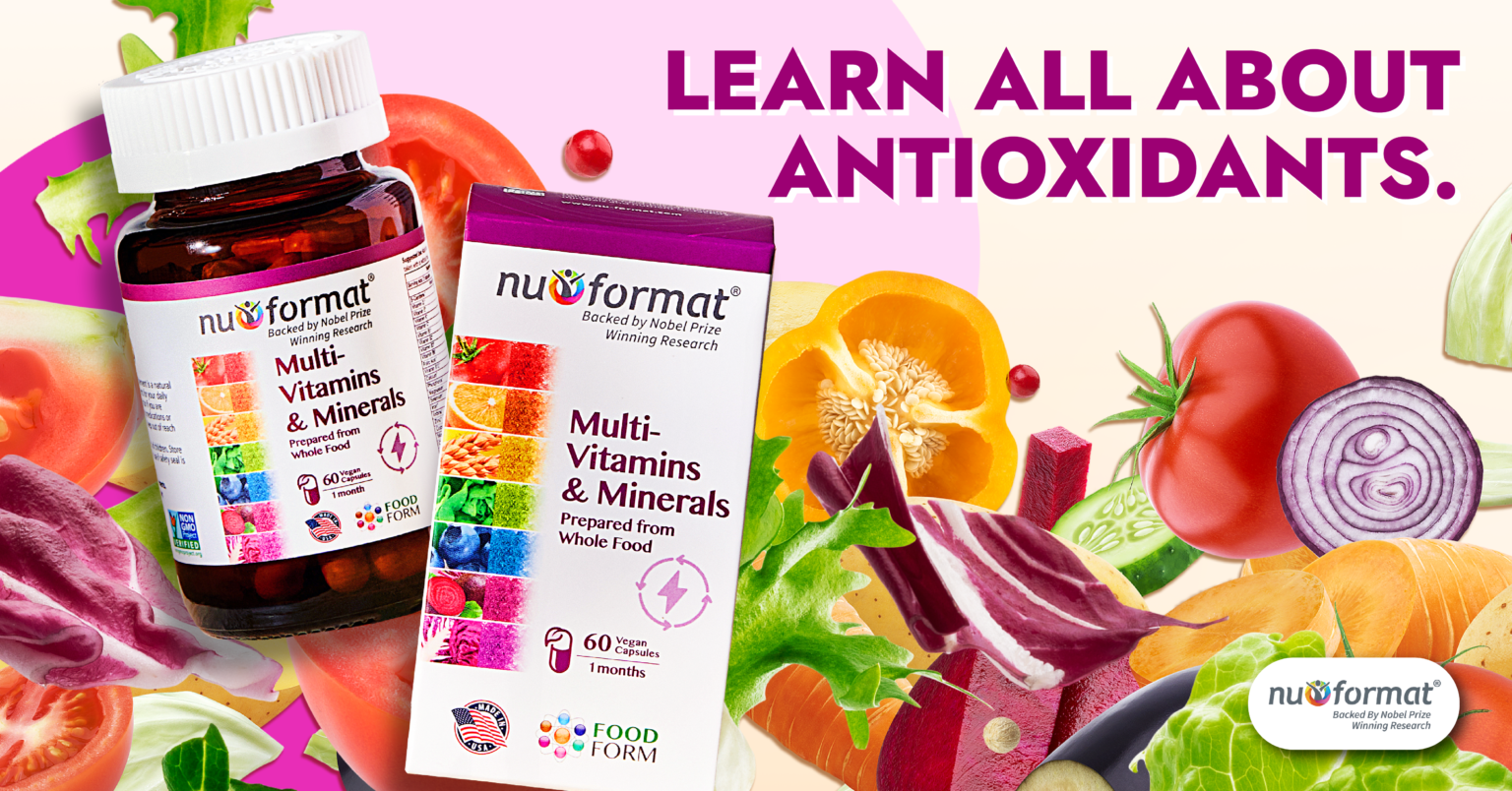Learn All About Antioxidants

Antioxidants have long been touted for a wide range of health benefits; including lowered risk of disease and anti-ageing properties. However, with the term “antioxidant” being used so often, how much do we really know and understand about antioxidants?
What are Antioxidants?
Antioxidants are compounds that are able to protect against and inhibit cellular damage by neutralising free radicals in the human body. Free radicals enter our body either as a byproduct of cell metabolism (i.e. our body producing energy) or from the environment (through sunlight or air pollution).
Free radicals contain an uneven number of electrons; making them highly reactive and unstable. In order to stabilise, free radicals will “steal” electrons from nearby molecules, which changes the structures of these molecules. This process is known as oxidation and it sets off a chain reaction where new free radical molecules are formed and the oxidation process repeats itself.
Antioxidants, on the other hand, are molecules that can donate electrons to oxidise free radicals in our bodies. They are produced in our bodies, but can also be obtained through the food that we eat.
Our bodies require both free radicals and antioxidants, but an imbalance between the two results in oxidative stress, which can permanently damage fatty tissues, DNA and proteins. This contributes to the development of chronic and degenerative illnesses such as ageing, cancer, autoimmune disorders and cardiovascular and neurodegenerative diseases.
Health benefits of antioxidants
Antioxidants lower the risks of developing oxidative stress-induced diseases, namely:
- Diabetes
- Atherosclerosis (hardening of the blood vessels)
- Arthritis and other inflammatory conditions
- High blood pressure (a.k.a. hypertension)
- Heart disease
- Neurodegenerative diseases (such as Parkinson’s and Alzheimer’s)
- Cancer
- Age-related macular degeneration (AMD) and cataracts
Types of antioxidants and where they are found

Glutathione
Produced in the liver, glutathione is a scavenging antioxidant that searches for active radicals to inhibit chain initiation and break chain propagation reactions. In order to reduce oxidative stress and boost glutathione levels (which decrease as we get older), one can consider consuming more selenium-rich foods.
Likewise, it is important to incorporate other trace minerals such as copper, manganese and zinc into diets as these minerals act as catalysts for antioxidant enzymes like superoxide dismutase.
Vitamin C
Aside from its potent antioxidant properties, Vitamin C is also responsible for regenerating other antioxidants (such as vitamin E) within the body and enhancing immune functions.
Vitamin C may also lower the risk of developing cardiovascular diseases and age-related macular degeneration (AMD). According to a Nurses Health Study published in the Journal of the American College of Cardiology, the intake of vitamin C from both dietary and supplemental sources was found to be inversely related to coronary heart disease risk. Similarly, an Age-Related Eye Disease Study (AREDS) on older individuals observed that after 6.5 years, participants who received high concentrations of antioxidants (500 mg vitamin C, 400 IU vitamin E, 15 mg beta-carotene, 80 mg zinc, and 2 mg copper) had a 28% lower risk of advanced AMD.
Since our bodies can’t produce vitamin C, it is essential to obtain it in our diet through foods such as citrus fruits, strawberries, tomatoes, red and green peppers and brussel sprouts.
Vitamin E
Vitamin E is obtained mainly from plant sources including sunflower seeds, olive oil and almonds. It works in synergy with vitamin C to prevent the formation of radical chain reactions. Several studies have also shown that vitamin E hinders the development of atherosclerosis by reducing oxidative stress.
Phenolic compounds
Phenolic compounds are antioxidants that are characterised as hydroxybenzoic acids, hydroxycinnamic acids and flavonoids, with diverse beneficial properties ranging from anti-diabetic, and anti-inflammatory to anti-cancer.
These compounds can be obtained from a variety of sources:
- Hydroxycinnamic acids (coffee)
- Quercetin (apples, red wine, onions)
- Catechins (tea, cocoa, berries)
- Resveratrol (red and white wine, grapes, peanuts, berries)
- Coumaric acid (spices, berries)
- Anthocyanins (blueberries, strawberries)
Not all antioxidants are made equal

Although available in both synthetic and natural forms, synthetic antioxidants that are commercially produced are highly volatile and unstable at elevated temperatures and can be potentially carcinogenic (i.e. cancer-causing) in nature.
In fact, according to Nutrition Studies Research Group, recent clinical trials have proven that isolated antioxidants in pill form are less efficacious than consuming whole foods that contain a combination of antioxidants and other components which may work synergistically together.
100% Safe, Food-State® supplements
Having a poor diet may deprive you of the necessary antioxidants and nutrients that you need to maintain a healthy lifestyle.
Nu-Format®’s Multivitamins and Minerals supplement encompass a spectrum of bioavailable essential nutrients and trace elements that support total well-being, optimal daily function and performance, and defence against free radicals.
Unlike synthetic supplements, Nu-Format® uses 100% whole food ingredients and makes use of an all-natural, targeted delivery system that produces the best results for your body, in the safest way possible.
Our Nobel-winning process employs baker’s yeast (Saccharomyces cerevisiae) as a natural bio-carrier, resulting in a supplement that contains nutrients bonded in a natural food matrix, just as nature intended!

Shop Nu-Format® Multivitamins & Minerals supplement today!
www.nu-format.com//products/multivitamins-minerals


